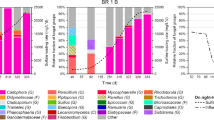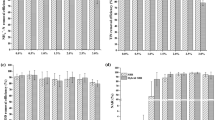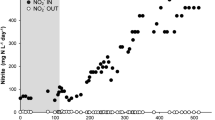Abstract
Kinetic parameters affecting effluent water quality including half saturation constant (Ks), maximum specific growth rate (μmax), and specific affinity (\( {a}_A^0 \), defined as μmax/Ks) were investigated using three types of anaerobic sludge (raw anaerobic digestion sludge referred to as unacclimated sludge, unacclimated sludge after endogenous decay, and sludge acclimated to low-strength wastewater in an anaerobic membrane bioreactor (AnMBR) for 360 days). Long-term acclimation to low-strength wastewater resulted in sludge with high specific affinity (1.6 × 10−3 L/mg COD/day for acclimated sludge compared to 4.1 × 10−4 L/mg COD/day for unacclimated sludge). The μmax values for unacclimated sludge and acclimated sludge were 0.08 and 0.07 day−1, respectively. The Ks values for unacclimated sludge and acclimated sludge were 194 ± 81 mg COD/L and 45 ± 13 mg COD/L, respectively. Although the Ks of unacclimated sludge after endogenous decay increased to 772 ± 74 mg COD/L, μmax increased to 0.35 day−1 as well, resulting in no statistically significant difference of \( {a}_A^0 \) between the two types of unacclimated sludge. Overall, \( {a}_A^0 \) is a better indicator than μmax or Ks alone for determining effluent water quality, as effluent substrate concentration is approximately inversely proportional to the specific affinity. 16S rRNA sequencing data analysis indicated a high abundance (85.8% of total archaea) of Methanosaeta in the microbial community after long-term acclimation. High \( {a}_A^0 \) associated with the enrichment of Methanosaeta appears to ensure successful anaerobic treatment of low-strength wastewater.





Similar content being viewed by others
References
Ahmadi E, Yousefzadeh S, Ansari M, Ghaffari HR, Azari A, Miri M, Mesdaghinia A, Nabizadeh R, Kakavandi B, Ahmadi P (2017) Performance, kinetic, and biodegradation pathway evaluation of anaerobic fixed film fixed bed reactor in removing phthalic acid esters from wastewater. Sci Rep 7:41020. https://doi.org/10.1038/srep41020
Arnaldos M, Amerlinck Y, Rehman U, Maere T, Van Hoey S, Naessens W, Nopens I (2015) From the affinity constant to the half-saturation index: understanding conventional modeling concepts in novel wastewater treatment processes. Water Res 70:458–470. https://doi.org/10.1016/j.watres.2014.11.046
Association APH, Association AWW, Federation WPC, Federation WE (2017) Standard methods for the examination of water and wastewater, vol 2. American Public Health Association, Washington, DC
Button DK (1993) Nutrient-limited microbial growth kinetics: overview and recent advances. Anton Leeuw Int J G 63(3-4):225–235. https://doi.org/10.1007/Bf00871220
Button DK (1998) Nutrient uptake by microorganisms according to kinetic parameters from theory as related to cytoarchitecture. Microbiol Mol Biol R 62(3):636–645
Button DK, Robertson B, Gustafson E, Zhao XM (2004) Experimental and theoretical bases of specific affinity, a cytoarchitecture-based formulation of nutrient collection proposed to supercede the Michaels-Menten paradigm of microbial kinetics. Appl Environ Microbiol 70(9):5511–5521. https://doi.org/10.1128/Aem.70.9.5511-5521.2004
Caporaso JG, Kuczynski J, Stombaugh J, Bittinger K, Bushman FD, Costello EK, Fierer N, Pena AG, Goodrich JK, Gordon JI, Huttley GA, Kelley ST, Knights D, Koenig JE, Ley RE, Lozupone CA, McDonald D, Muegge BD, Pirrung M, Reeder J, Sevinsky JR, Tumbaugh PJ, Walters WA, Widmann J, Yatsunenko T, Zaneveld J, Knight R (2010) QIIME allows analysis of high-throughput community sequencing data. Nat Methods 7(5):335–336. https://doi.org/10.1038/nmeth.f.303
Conklin A, Stensel HD, Ferguson J (2006) Growth kinetics and competition between Methanosarcina and Methanosaeta in mesophilic anaerobic digestion. Water Environ Res 78(5):486–496. https://doi.org/10.2175/106143006x95393
De Vrieze J, Hennebel T, Boon N, Verstraete W (2012) Methanosarcina: the rediscovered methanogen for heavy duty biomethanation. Bioresour Technol 112:1–9. https://doi.org/10.1016/j.biortech.2012.02.079
Dunfield PF, Conrad R (2000) Starvation alters the apparent half-saturation constant for methane in the type II methanotroph Methylocystis strain LR1. Appl Environ Microbiol 66(9):4136–4138
Edgar RC (2013) UPARSE: highly accurate OTU sequences from microbial amplicon reads. Nat Methods 10(10):996–998. https://doi.org/10.1038/Nmeth.2604
Gonzalez-Estrella J, Asato CM, Jerke AC, Stone JJ, Gilcrease PC (2017) Effect of structural carbohydrates and lignin content on the anaerobic digestion of paper and paper board materials by anaerobic granular sludge. Biotechnol Bioeng 114(5):951–960. https://doi.org/10.1002/bit.26228
Grady CL Jr, Daigger GT, Love NG, Filipe CD (2011) Biological wastewater treatment. CRC press, Boca Raton
Healey F (1980) Slope of the Monod equation as an indicator of advantage in nutrient competition. Microb Ecol 5(4):281–286. https://doi.org/10.1007/BF02020335
Henze M, van Loosdrecht MC, Ekama GA, Brdjanovic D (2008) Biological wastewater treatment. IWA publishing, London
Huang YX, Guo JL, Zhang CY, Hu ZQ (2016) Hydrogen production from the dissolution of nano zero valent iron and its effect on anaerobic digestion. Water Res 88:475–480. https://doi.org/10.1016/j.watres.2015.10.028
Kato MT, Field JA, Versteeg P, Lettinga G (1994) Feasibility of expanded granular sludge bed reactors for the anaerobic treatment of low-strength soluble wastewaters. Biotechnol Bioeng 44(4):469–479
Kim TG, Jeong S-Y, Cho K-S (2015) Development of droplet digital PCR assays for methanogenic taxa and examination of methanogen communities in full-scale anaerobic digesters. Appl Microbiol Biotechnol 99(1):445–458. https://doi.org/10.1007/s00253-014-6007-x
Klappenbach JA, Saxman PR, Cole JR, Schmidt TM (2001) rrndb: the ribosomal RNA operon copy number database. Nucleic Acids Res 29(1):181–184. https://doi.org/10.1093/nar/29.1.181
Kovarova-Kovar K, Egli T (1998) Growth kinetics of suspended microbial cells: from single-substrate-controlled growth to mixed-substrate kinetics. Microbiol Mol Biol R 62(3):646–666
Lagostina L, Goldhammer T, Røy H, Evans TW, Lever MA, Jørgensen BB, Petersen DG, Schramm A, Schreiber L (2015) Ammonia-oxidizing bacteria of the Nitrosospira cluster 1 dominate over ammonia-oxidizing archaea in oligotrophic surface sediments near the South Atlantic Gyre. Environ Microbiol Rep 7(3):404–413. https://doi.org/10.1111/1758-2229.12264
Lengeler JW, Drews G, Schlegel HG (1999) Biology of the prokaryotes. Georg Thieme Verlag, Stuttgart
Li LL, Tong ZH, Fang CY, Chu J, Yu HQ (2015) Response of anaerobic granular sludge to single-wall carbon nanotube exposure. Water Res 70:1–8. https://doi.org/10.1016/j.watres.2014.11.042
Li N, Hu Y, Lu Y-Z, Zeng RJ, Sheng G-P (2016) In-situ biogas sparging enhances the performance of an anaerobic membrane bioreactor (AnMBR) with mesh filter in low-strength wastewater treatment. Appl Microbiol Biotechnol 100(13):6081–6089. https://doi.org/10.1007/s00253-016-7455-2
Lopez C, Pons M, Morgenroth E (2006) Endogenous processes during long-term starvation in activated sludge performing enhanced biological phosphorus removal. Water Res 40(8):1519–1530. https://doi.org/10.1016/j.watres.2006.01.040
Matin A, Auger E, Blum P, Schultz J (1989) Genetic basis of starvation survival in nondifferentiating bacteria. Annu Rev Microbiol 43(1):293–314. https://doi.org/10.1146/annurev.mi.43.100189.001453
Mee RW, Chua TC (1991) Regression toward the mean and the paired sample t test. Am Stat 45(1):39–42. https://doi.org/10.2307/2685237
Nedwell DB (1999) Effect of low temperature on microbial growth: lowered affinity for substrates limits growth at low temperature. FEMS Microbiol Ecol 30(2):101–111
Nobu MK, Narihiro T, Kuroda K, Mei R, Liu W-T (2016) Chasing the elusive Euryarchaeota class WSA2: genomes reveal a uniquely fastidious methyl-reducing methanogen. ISME J 10:2478–2487. https://doi.org/10.1038/ismej.2016.33
Nowka B, Daims H, Spieck E (2015) Comparison of oxidation kinetics of nitrite-oxidizing bacteria: nitrite availability as a key factor in niche differentiation. Appl Environ Microbiol 81(2):745–753. https://doi.org/10.1128/AEM.02734-14
Owens J, Legan J (1987) Determination of the Monod substrate saturation constant for microbial growth. FEMS Microbiol Lett 46(4):419–432. https://doi.org/10.1111/j.1574-6968.1987.tb02478.x
Pavlostathis SG, Giraldogomez E (1991) Kinetics of anaerobic treatment. Water Sci Technol 24(8):35–59. https://doi.org/10.1080/10643389109388424
Picioreanu C, Perez J, van Loosdrecht MC (2016) Impact of cell cluster size on apparent half-saturation coefficients for oxygen in nitrifying sludge and biofilms. Water Res 106:371–382. https://doi.org/10.1016/j.watres.2016.10.017
Quast C, Pruesse E, Yilmaz P, Gerken J, Schweer T, Yarza P, Peplies J, Glockner FO (2013) The SILVA ribosomal RNA gene database project: improved data processing and web-based tools. Nucleic Acids Res 41(D1):D590–D596. https://doi.org/10.1093/nar/gks1219
Rittmann BE, McCarty PL (2012) Environmental biotechnology: principles and applications. Tata McGraw-Hill Education, Boston
Rolfe MD, Rice CJ, Lucchini S, Pin C, Thompson A, Cameron AD, Alston M, Stringer MF, Betts RP, Baranyi J (2012) Lag phase is a distinct growth phase that prepares bacteria for exponential growth and involves transient metal accumulation. J Bacteriol 194(3):686–701. https://doi.org/10.1128/JB.06112-11
Romao BB, Batista FRX, Ferreira JS, Costa HCB, Resende MM, Cardoso VL (2014) Biohydrogen production through dark fermentation by a microbial consortium using whey permeate as substrate. Appl Biochem Biotechnol 172(7):3670–3685. https://doi.org/10.1007/s12010-014-0778-5
Rongwong W, Goh K, Bae T-H (2018) Energy analysis and optimization of hollow fiber membrane contactors for recovery of dissolve methane from anaerobic membrane bioreactor effluent. J Membr Sci 554:184–194. https://doi.org/10.1016/j.memsci.2018.03.002
Shaw A, Takacs I, Pagilla K, Riffat R, DeClippeleir H, Wilson C, Murthy S (2015) Toward universal half-saturation coefficients: describing extant Ks as a function of diffusion. Water Environ Res 87(5):387–391. https://doi.org/10.2175/106143015X14212658614072
Smith AL, Skerlos SJ, Raskin L (2015) Anaerobic membrane bioreactor treatment of domestic wastewater at psychrophilic temperatures ranging from 15 degrees C to 3 degrees C. Environ Sci-Wat Res 1(1):56–64. https://doi.org/10.1039/c4ew00070f
Thomas R, Vaughan I, Lello J (2013) Data analysis with R statistical software. Eco-explore, Wales
van Lier JB, Mahmoud N, Zeeman G (2008) Anaerobic wastewater treatment. In Birkett J., Lester J. (eds) Microbiology and chemistry for environmental scientists and engineers. CRC Press, London, pp: 415-456
Vasquez J, Nakasaki K (2018) Effects of acclimated sludge used as seeding material in the start-up of anaerobic digestion of glycerol. J Mater Cycles Waste 20(1):185–192. https://doi.org/10.1007/s10163-016-0560-6
Walters W, Hyde ER, Berg-Lyons D, Ackermann G, Humphrey G, Parada A, Gilbert JA, Jansson JK, Caporaso JG, Fuhrman JA, Apprill A, Knight R (2016) Improved bacterial 16S rRNA gene (V4 and V4-5) and fungal internal transcribed spacer marker gene primers for microbial community surveys. Msystems 1(1):e00009–e00015. https://doi.org/10.1128/mSystems.00009-15
Wilkinson AJ, Fersht AR, Blow D, Carter P, Winter G (1984) A large increase in enzyme-substrate affinity by protein engineering. Nature 307(5947):187–188
Yang Y, Chen Q, Wall JD, Hu Z (2012) Potential nanosilver impact on anaerobic digestion at moderate silver concentrations. Water Res 46(4):1176–1184. https://doi.org/10.1016/j.watres.2011.12.024
Yu C-P, Liang Z, Das A, Hu Z (2011) Nitrogen removal from wastewater using membrane aerated microbial fuel cell techniques. Water Res 45(3):1157–1164. https://doi.org/10.1016/j.watres.2010.11.002
Author information
Authors and Affiliations
Corresponding authors
Ethics declarations
Conflict of interest
The authors declare that they have no conflict of interest.
Ethical approval
This article does not contain any studies with human participants or animals performed by any of the authors.
Additional information
Publisher’s note
Springer Nature remains neutral with regard to jurisdictional claims in published maps and institutional affiliations.
Electronic supplementary material
ESM 1
(PDF 555 kb).
Rights and permissions
About this article
Cite this article
Hou, L., Griswold, N., Ji, J. et al. Specific affinity and relative abundance of methanogens in acclimated anaerobic sludge treating low-strength wastewater. Appl Microbiol Biotechnol 104, 291–302 (2020). https://doi.org/10.1007/s00253-019-10149-x
Received:
Revised:
Accepted:
Published:
Issue Date:
DOI: https://doi.org/10.1007/s00253-019-10149-x




